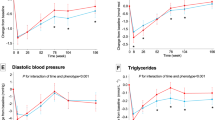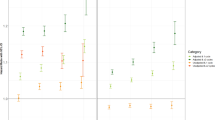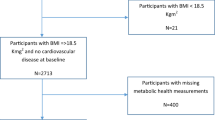Abstract
Objective:
The purpose of this study was to apply obesity treatment algorithms to a representative sample of Canadians to determine their potential impact on the population.
Design:
The Canadian Heart Health Surveys (1986–1992) were used to describe the prevalence of adults (18–64 y) that would be eligible for weight loss treatment according to the US NIH algorithm, which uses body mass index (BMI), waist circumference (WC), and the presence of two or more cardiovascular disease (CVD) risk factors. Similar algorithms based on CVD risk factors and a single measure of either BMI or WC alone were also evaluated.
Results:
Using the NIH algorithm, 24% of Canadians (28% men, 19% women) would be identified for weight loss treatment. Virtually, all subjects received the same treatment recommendations when using BMI and CVD risk factors only, while 22% (23% men, 21% women) would meet the criteria for treatment using WC and CVD risk factors only.
Conclusions:
Approximately one in four Canadians would be eligible for weight loss treatment using the NIH obesity treatment algorithm. However, the algorithm may be improved through the incorporation of more sensitive WC thresholds.
This is a preview of subscription content, access via your institution
Access options
Subscribe to this journal
Receive 12 print issues and online access
$259.00 per year
only $21.58 per issue
Buy this article
- Purchase on Springer Link
- Instant access to full article PDF
Prices may be subject to local taxes which are calculated during checkout


Similar content being viewed by others
References
Ardern CI, Janssen I, Ross R & Katzmarzyk PT (2004): Development of health-related waist circumference thresholds within body mass index categories. Obes. Res. 12, 1094–1103.
Ardern CI, Katzmarzyk PT, Janssen I & Ross R (2003): Discrimination of health risk by combined body mass index and waist circumference. Obes. Res. 11, 135–142.
Dobbelsteyn CJ, Joffres MR, MacLean DR & Flowerdew G (2001): A comparative evaluation of waist circumference, waist-to-hip ratio and body mass index as indicators of cardiovascular risk factors. Int. J. Obes. Relat. Metab. Disord. 25, 652–661.
Janssen I, Katzmarzyk PT & Ross R (2002): Body mass index, waist circumference, and health risk: evidence in support of current National Institutes of Health guidelines. Arch. Intern. Med. 162, 2074–2079.
Janssen I, Katzmarzyk PT & Ross R (2004): Duration of overweight and metabolic health risk in American men and women. Ann. Epidemiol. 14, 585–591.
Jeffery RW, Drewnowski A, Epstein LH, Stunkard AJ, Wilson GT, Wing RR & Hill DR (2000): Long-term maintenance of weight loss: current status. Health Psychol. 19, 5–16.
Katzmarzyk PT (2002): The Canadian obesity epidemic, 1985–1998. Can. Med. Assoc. J. 166, 1039–1040.
Kiernan M & Winkleby MA (2000): Identifying patients for weight-loss treatment: an empirical evaluation of the NHLBI obesity education initiative expert panel treatment recommendations. Arch. Intern. Med. 160, 2169–2176.
Lean ME, Han TS & Morrison CE (1995): Waist circumference as a measure for indicating need for weight management. BMJ 311, 158–161.
MacLean DR, Petrasovits A, Nargundkar M, Connelly PW, MacLeod E, Edwards A & Hessel P (1992): Canadian Heart Health Surveys: a profile of cardiovascular risk. Survey methods and data analysis. Can. Med. Assoc. J. 146, 1969–1974.
McTigue KM, Harris R, Hemphill B, Lux L, Sutton S, Bunton AJ & Lohr KN (2003): Screening and interventions for obesity in adults: summary of the evidence for the U.S. Preventive Services Task Force. Ann. Intern. Med. 139, 933–949.
Rankinen T, Kim SY, Perusse L, Despres JP & Bouchard C (1999): The prediction of abdominal visceral fat level from body composition and anthropometry: ROC analysis. Int. J. Obes. Relat. Metab. Disord. 23, 801–809.
Statistics Canada (1992): A National Overview. Catalogue No. 93-301. Ottawa: Supply and Services Canada.
Torrance GM, Hooper MD & Reeder BA (2002): Trends in overweight and obesity among adults in Canada (1970–1992): Evidence from national surveys using measured height and weight. Int. J. Obes. Relat. Metab. Disord. 26, 797–804.
U.S. National Institutes of Health (1998): Clinical guidelines on the identification, evaluation, and treatment of overweight and obesity in adults: the evidence report. Obes. Res. 6, S51–S210.
World Health Organization (1998): Obesity: Preventing and Managing a Global Epidemic. Report of a WHO Consultation on Obesity, Geneva, 3–5 June. Geneva: World Health Organization.
Acknowledgements
This research was supported by a New Emerging Team grant from the Canadian Institutes for Health Research and the Heart and Stroke Foundation of Canada. C Mason is supported by a Master's Studentship Award from the Heart and Stroke Foundation of Ontario.
Author information
Authors and Affiliations
Corresponding author
Additional information
Guarantor: PT Katzmarzyk.
Contributors: Both CM and PTK contributed to the conception of the research. CM conducted the analysis and prepared the first draft of the manuscript. PTK aided with the interpretation of the results and the editing of the manuscript.
Rights and permissions
About this article
Cite this article
Mason, C., Katzmarzyk, P. Application of obesity treatment algorithms to Canadian adults. Eur J Clin Nutr 59, 797–800 (2005). https://doi.org/10.1038/sj.ejcn.1602140
Received:
Revised:
Accepted:
Published:
Issue Date:
DOI: https://doi.org/10.1038/sj.ejcn.1602140
Keywords
This article is cited by
-
Morbidity and Mortality Risk Associated With an Overweight BMI in Older Men and Women*
Obesity (2007)
-
Validity of overweight and obesity in a nation based on self-report versus measurement device data
European Journal of Clinical Nutrition (2006)



